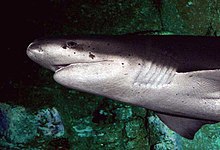
Carcharhiniformes, the ground sharks, are the largest order of sharks, with over 270 species. They include a number of common types, such as catsharks, swellsharks, and the sandbar shark.

Scyliorhinus is a genus of catsharks in the family Scyliorhinidae. This genus is known in the fossil records from the Cretaceous period, late Albian age to the Pliocene epoch.
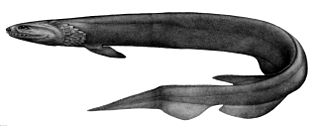
The frilled shark, also known as the lizard shark, is one of the two extant species of shark in the family Chlamydoselachidae. The frilled shark is considered a living fossil, because of its primitive, anguilliform (eel-like) physical traits, such as a dark-brown color, amphistyly, and a 2.0 m (6.6 ft)–long body, which has dorsal, pelvic, and anal fins located towards the tail. The common name, frilled shark, derives from the fringed appearance of the six pairs of gill slits at the shark's throat.

Chlamydoselachidae is a family of primitive deep-sea sharks in the order Hexanchiformes. They are one of only two extant families in the order alongside the cow sharks in the family Hexanchidae, and the only members of the suborder Chlamydoselachoidei.

Carpet sharks are sharks classified in the order Orectolobiformes. Sometimes the common name "carpet shark" is used interchangeably with "wobbegong", which is the common name of sharks in the family Orectolobidae. Carpet sharks have five gill slits, two spineless dorsal fins, and a small mouth that does not extend past the eyes. Many species have barbels.
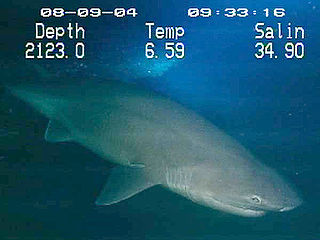
Cow sharks are a shark family, the Hexanchidae, characterized by an additional pair or pairs of gill slits. Its 37 species are placed within the 10 genera: Gladioserratus, Heptranchias, Hexanchus, Notidanodon, Notorynchus, Pachyhexanchus, Paraheptranchias, Pseudonotidanus, Welcommia, and Weltonia.

The Lamnidae are the family of mackerel sharks known as white sharks. They are large, fast-swimming predatory fish found in oceans worldwide, though prefer environments with colder water. The name of the family is formed from the Greek word lamna, which means "fish of prey", and was derived from the Greek legendary creature, the Lamia.

Chlamydoselachus is a genus of sharks and the sole extant member of the family Chlamydoselachidae, in the order Hexanchiformes. It contains two extant and four extinct species. The most widely known species still surviving is the frilled shark. It is known as a living fossil, along with Chlamydoselachus africana, also known as the southern African frilled shark, which is only found along coastal areas of South Africa. The only two extant species of this genus are deep-sea creatures which are typically weakened in areas closer to the surface. While the two extant species are similar in external appearance, they differ internally.
The sixgill sharks are a genus, Hexanchus, of deepwater sharks in the family Hexanchidae. These sharks are characterized by a broad, pointed head, six pairs of gill slits, comb-like, yellow lower teeth, and a long tail. The largest species can grow up to 8 m long and weigh over 600 kg (1320 lb). They are continental shelf-dwelling and abyssal plain scavengers with a keen sense of smell and are among the first to arrive at carrion, together with hagfish and rattails. They show a characteristic rolling motion of the head when feeding.
The shark order Hexanchiformes is often considered the most primitive of extant sharks, since they share some features with Paleozoic and early-Mesozoic shark groups as the Cladoselachiformes. Thus, it is interesting to see how far back the fossil record of this order reaches.
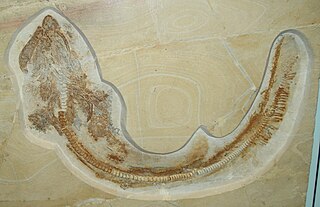
Paraorthacodus is an extinct genus of shark. It a member of the family Paraorthacodontidae, which is either placed in Hexanchiformes or in Synechodontiformes. It is known from over a dozen named species spanning from the Early Jurassic to the Paleocene, or possibly Eocene. Almost all members of the genus are exclusively known from isolated teeth, with the exception of P. jurensis from the Late Jurassic-Early Cretaceous of Europe, which is known from full body fossils from the Late Jurassic of Germany, which suggest that juveniles had a robust body with a round head, while adults had large body sizes with a fusiform profile. There was only a single dorsal fin towards the back of the body without a fin spine. The dentition had teeth with a single large central cusp along with shorter lateral cusplets, which where designed for clutching. The teeth are distinguished from those of Synechodus by the lateral cusplets decreasing in size linearly away from the central cusp rather than exponentially as in Synechodus.
Gladioserratus is an extinct genus of cow shark. It contains three species:
Mcmurdodus is an extinct genus of chondrichthyan belonging to the family Mcmurdodontidae. It contains one species, Mcmurdodus featherensis, from the Middle Devonian of Antarctica. The Australian species M. whitei was previously included in the genus too, but was moved to a new genus, Maiseyodus, in 2021.

Orthacodontidae is an extinct family of sharks. It is disputed as to whether it belongs to the modern shark order Hexanchiformes, or the extinct order Synechodontiformes. It contains two genera. Some other authors included it in Lamniformes.

Pseudocorax is an extinct genus of mackerel sharks that lived during the Late Cretaceous. It contains six valid species that have been found in Europe, the Middle East, North Africa, and North America. It was formerly assigned to the family Anacoracidae, but is now placed in its own family Pseudocoracidae along with Galeocorax. The former species "P." australis and "P." primulus have been reidentified as species of Echinorhinus and Squalicorax, respectively.

Synechodontiformes is an extinct order of prehistoric shark-like cartilaginous fish, known from the Permian to the Paleogene. They are considered to be members of Neoselachii, the group that contains modern sharks and rays.
Notidanodon is an extinct genus of cow shark. Fossils ascribed to this genus are known from the Jurassic and Cretaceous periods. Recently, the genus underwent a major revision and was split into two after the erection of Xampylodon to accommodate the species X. dentatus, X. loozi, and X. brotzeni. The genus is now known only from New Zealand, Antarctica, Africa, and South America.
Rolfodon is an extinct genus of shark in the family Chlamydoselachidae. It is closely related to the extant frilled sharks in the genus Chlamydoselachus, which it can be differentiated from by tooth morphology. It is named after late Canadian paleontologist Rolf Ludvigsen.
Dykeius is an extinct genus of large shark in the family Chlamydoselachidae. It contains a single known species, D. garethi, from the Late Cretaceous Northumberland Formation of Canada. The genus and species names honor paleontologist Gareth J. Dyke.
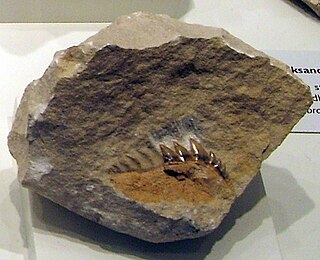
Xampylodon is an extinct genus of cow shark. Fossils assigned to this genus are known from the Late Cretaceous and early Paleocene. Xampylodon was recently erected after a revision on the taxonomy of hexanchid fossil teeth, and includes four species, most of them previously included in Notidanodon.
